If you’ve been working in the digital marketing industry, then the word “keyword” probably needs no introduction. Generally speaking, keywords are terms or phrases that carry a high value. They form the connection between what a person is looking for and the result generated for them by a search engine.
Moreover, keywords help you to zero down onto a target audience as opposed to spending your time, energy and capital on a larger crowd. You can think of keywords as tags that help segregate content and define them. To find the right keywords for every piece, you need to conduct keyword research.
This research allows you to identify the necessary terms or phrases you must include in your piece. And to find out these, you need to rely on a keyword research tool.
What is a keyword research tool?
A Keyword Research Tool can help you to identify the key trending phrases , their rankings and competitiveness. But it cannot magically do so! The first step to any research process is to define the methodology and problem statement. A tool can aid, but it cannot perform the entire operation.
So, before resorting to a tool, ask yourself some questions.
What is it that you are promoting?
Let’s assume you are promoting a new speaker.
What is the target audience for this kind of product?
Based on earlier data, you might have a fixed segment in mind. For now, let us look at an age group of 20 – 35-year-olds.
How will the target audience prefer to search for this product?
They will prefer to be directed to a shopping site, look for listed features, or look for reviews in the form of articles and videos.
What kind of keywords will they use for this?
It is likely that they are going to add words like ‘review’, ‘buy’, ‘compare to’ with the product name. You can conduct a quick search on Google to see the most searched phrases that crop up.
What kind of devices are people using the access this data?
This might affect your page structuring.
What is it that people expect from such a product?
Products provide fulfilment, and your content must amplify this. If people look for speakers with good bass, that could be an important keyword in your advertising.
What are your competitors doing?
A competitor site analysis can provide great insights into the type of strategies they are using. You can use this to identify gaps and opportunities for your own strategy. There are various tools available that help to identify competitors (if you haven’t recognized them already). These tools look at brands with overlapping audiences. One such tool is the Alexa Tool.
With the answers to these questions, you now have some data regarding how you can rank on search engines organically. This is where the tools come in. Now, by following up on these leads, you can select the appropriate phrases, find common FAQs, look for parent phrases, content idea, rich results and so on.
How keywords can improve your site’s performance on SERP’s
Search engine algorithms cannot scan every article if they want to generate quick results. What they can do, however, is scan for specific keywords and topic clusters. Thus, keywords form the crux of SEO and could be the deciding factor for your page’s ranking among the SERPs.
The final position among the result depends on:
- The topic they are searching for
- The volume of people looking for the keyword
- The format they require their results in (images, videos, articles)
- How closely a particular topic is related to the keyword
So, here’s what you must know before delving into these tools.
1. Finding the right keywords
In the earlier section, we had a look at how one can identify what the common keywords for any product can be. The next step would be to enter these into the tool and see what are similar trending phrases. Tools also present the average search volume for these words and their overall growth chart.
You might have to try out a combination of different keywords to find one that ranks well. One must also understand that keywords are used to label pages. They do not label entire websites.
2. Search volume
The search volume is used to indicate the keyword difficulty level. A keyword with a high search volume means more people are looking for it. But, this does not automatically guarantee a large audience. In fact, a new start-up might very well get lost within it.
On the other hand, low-competition keywords mean you risk reaching out to a small crowd. Depending on the status of your business, you might want to target medium-competition keywords or those that are slightly more specific. This brings us to the next section.
3. Long-tail keywords
A single word is usually not enough definition. Unless that word refers to a brand name. Stand-alone words like speakers, skincare, jeans, etc. are extremely hard to rank for and also are not specific enough to get users to what they want. Most people search using 3-5 words.
A simple search for “speaker” will likely yield some speaker shopping sites and reviews from the top brands. In fact, the top 10,000 keywords constitute 18.5% of all searches made. Whereas long-tail keywords constitute 70% of the searches, though their number of monthly searches are much lower.
Long-tail keywords are the most searched terms in the form of phrases. Hence, it would be something like ‘speakers in India with good bass’.
4. Filtering keywords by region, competitor, season
Now there are several keywords that see a spike, but only in certain regions or during certain times of the year. For example, November-December might see a spike in ‘New Year gifts’.
Another way is to look at what your competitors used and missed out on. You can either use some that they are already using (is it a proven success?) or target the ones they left out.
Every keyword tool offers a region-wise breakdown. This is because many trends are local! And also because of colloquialism. While those in New York may look for ‘Christmas Cookies’, a Londoner might want a ‘Christmas biscuit’.
While most keyword research tools offer some common features, many have unique rankings that could be more suited for your industry. So, let’s take a look at some top tools, and what they have to offer.
Best keyword research tools
1. SurferSEO – The overall master
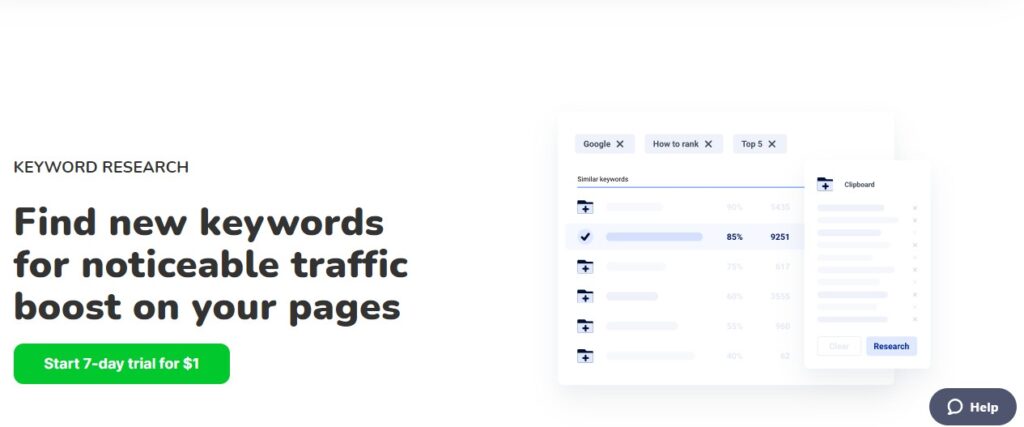
SurferSEO is a content strategy tool that offers many things – a content editor, SEO audits, a SERP analyzer and most importantly a Keyword Research tool which we are going to explore.
The Surfer Keyword Research works on the principle of tracking commonly used keys and phrases across top-ranking pages. It then generates a comprehensive list of those NLP keywords, term frequencies, meta tags and more.
What we like: SERP similarity
To analyze a seed term all you need is do is type it out and Surfer SEO will return a list of plausible similar keywords with their search volume. However, it also offers a SERP similarity percentage. This is essentially a measure of the similarity between the results for that keyword and the seed term you have typed in. Surfer SEO works for both single and multi-keyword inputs.
This can help you understand whether you need to create multiple topics for a single niche or not. You can change the location of your search to access region-wise keyword rankings.
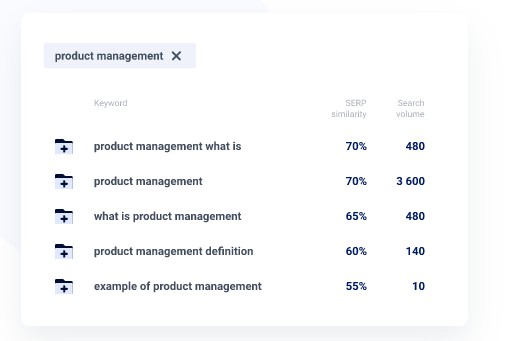
Apart from this, you can export the data anytime, and choose to look for other similar terms and questions from the navigation tabs. By clicking on the plus sign, you can add the keywords you need to a list without copy-pasting them.
Integration with content editor
An interesting integration offered is that after researching keywords, you can instantly access their Content Editor to create a content plan. The content plan is created from the selected keywords added in the earlier step. The content plan incorporates selected long-tail keywords and FAQs as topic notes. It must be noted that SurferSEO analyses top-used words hence there are often terms from footnotes or other places that do not make much sense and are not always related to the topic at hand.

On running a search for the Australian bird Currawong, we came across several terms like “search pied currawong” that do not make grammatical sense.
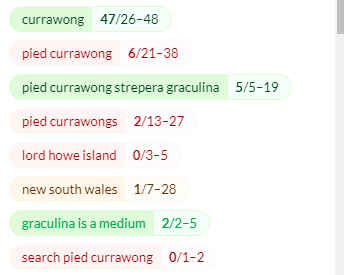
On clicking on it, you can see an example of where it was drawn from. And in this case, it seems to be from a disclaimer note. So some form of manual filtering is certainly required.
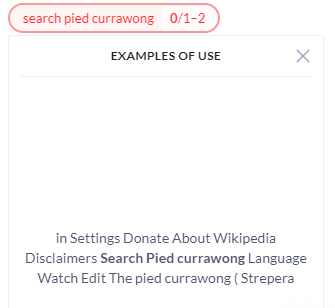
Site audit based on keyword
The SEO Audit tool allows you to compare your page and a competitor page based on its ranking for a certain keyword. What SurferSEO checks are the optimal word count range, keyword density, loading speed and readability.
Overall, SurferSEO offers a decent analysis and have many tools that make it an ideal platform for its pricing range. However, if you are only looking for a keyword analysis platform, then we suggest you take a look at the other platforms which we discussed which offer greater details.
2. Soovle – The free tool
If you are looking for something efficient that collects data from over 150 different search engines, then Soovle is the platform for you. It not only looks across Google but also top searches for Bing, Amazon and Yahoo.
What we love: Easy keyword extraction
All you have to do is type the keyword into the search box and check out the results for different platforms e.g. Google, YouTube, Amazon, Bing.
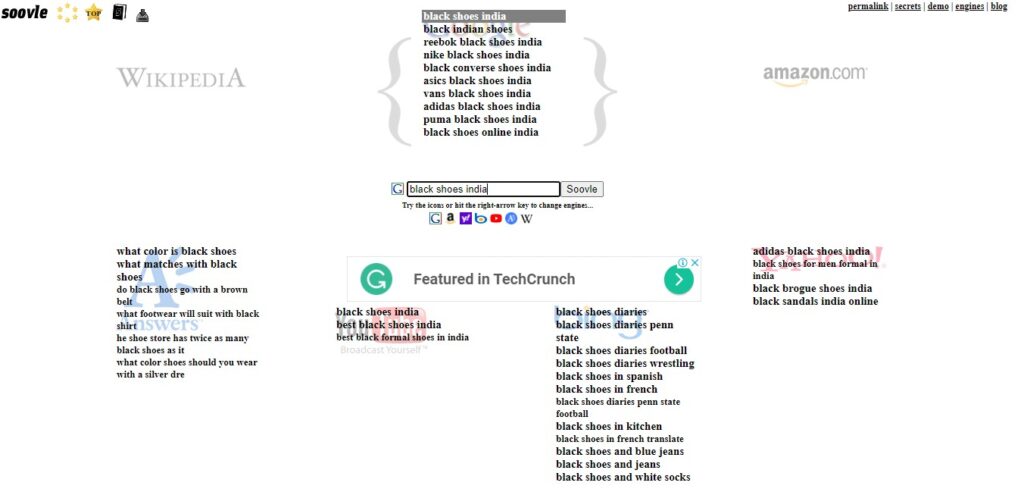
By clicking on the rightmost button on the top-left corner, you can download these in the form of a CSV file. You can also check out the top keywords on any given date by clicking the star with TOP written on it.
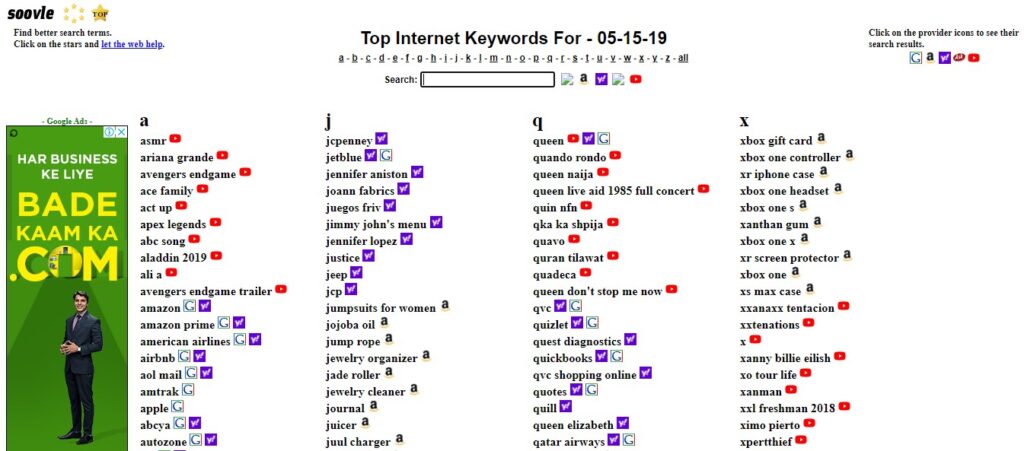
All your earlier searches are saved under the Saved Suggestions option. Soovle’s major advantage is that it is free.
3. SECockpit – For multiple keywords
SECockpit is a cloud-based website planning tool. And with 200 keywords scanned every minute, it’s the fastest of the lot! Other keyword research tools might only be able to run 1 or 2 searches within the same time. Made by Swiss Made Marketing, the company offers many other SEO tools including YTCockpit (which only looks at Youtube keywords) and a Rank Tracker.
Keyword breakdown
The SECockpit dashboard is exemplary for filtering and sifting through keywords. You can filter them based on country, local regions, phrases, result sites and more.
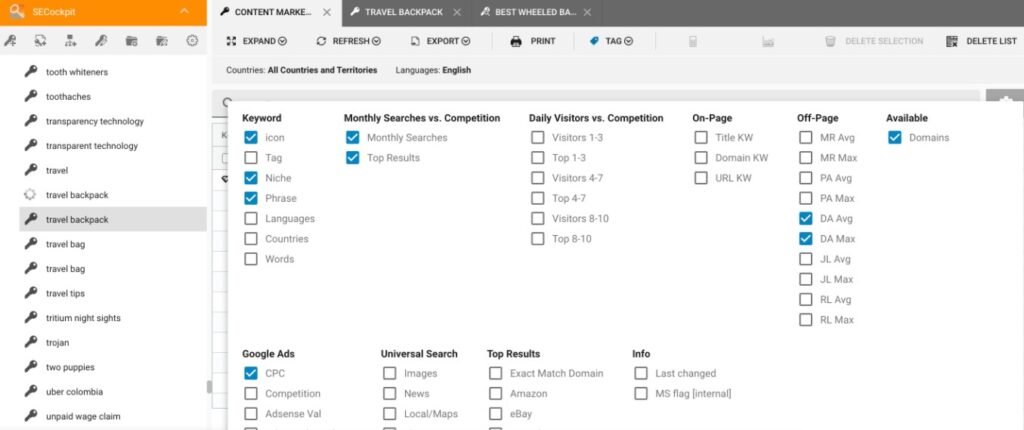
They offer three tabs – for Keywords, Projects and Tasks.
Under the keywords header, you can create new folders and save all related data within them to refer to later. Projects include your own web pages so you can quickly refer to deep dive and rank them. This tab deals with backlinks, logs, overlink links and so on. The Tasks tab provides an overview of the various features. It contains tutorials and introduction videos.
What we love: Rank tracker tool
The Rank Tracker is a cloud-based feature (no installation needed!) that automatically keeps monitoring and updating the keywords you are currently tracking. It offers ranking based on cities, and for keywords in all Google-supported languages.
Moreover, with a single plan, you can track as many keywords as you want. SECockpit’s plan comes without any limits. SECockpit does not limit its data to its own generated content but retrieves data from neutral non-personalized search results across local regions.
You can try SECockpit for free for a period of 7 days. After this, the lowest-tier plan starts at 25 USD per month.
4. Keywordtool.io – For long-tail keywords
Another free tool on the list is the KeywordTool.io. As of now, Keyword Tool is available in 83 different languages and comes with a Keyword Tool Pro version that allows up to 10 user accounts and costs 159 USD per month.
Keyword Tool’s major advantage is that it can search for data across multiple search engines like YouTube, Amazon, PlayStore and more. Keyword Tool’s main disadvantage lies in the fact that it simply uses Google Autocomplete to find the results. All the platform really implements is Google Suggest across various regions and presents the data in a tabulated format.
Keyword breakdown
The free version simply provides a list of keywords generated by the autocomplete feature. As such, Soovle offers a much more intuitive UI. However, the paid version offers details regarding search volume, CPC and current trend.
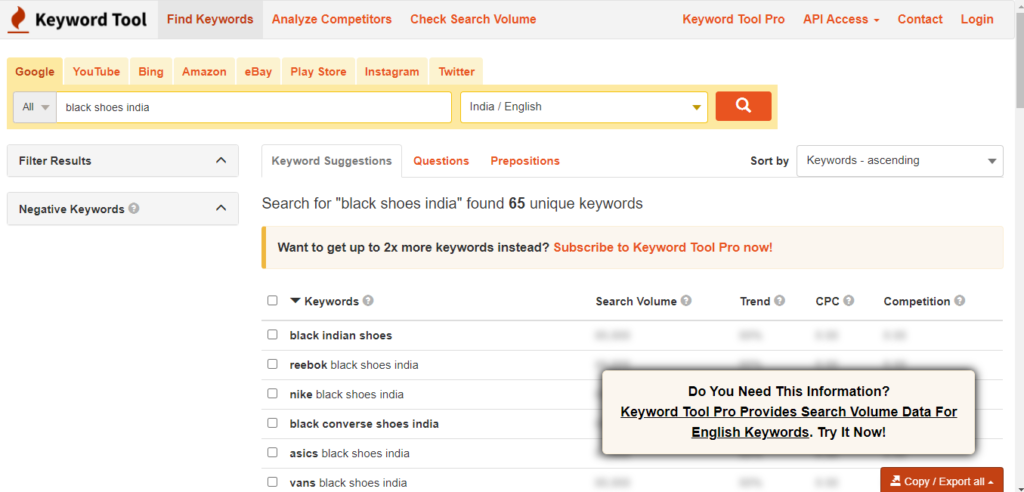
Another interesting paid feature is Keyword Tool automatically generates the most lucrative keywords with the medium-level competition.
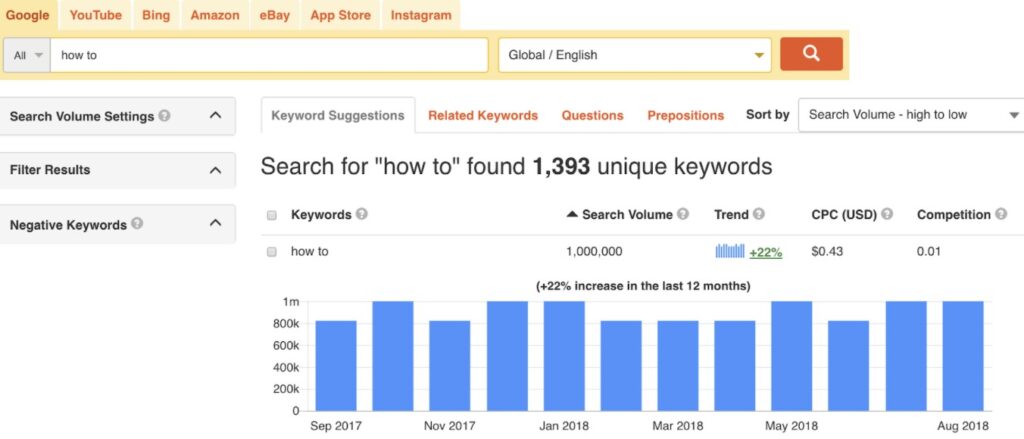
Comparing the results found by Google Keyword Planner and Keyword Tool, the latter offers more relevant long-tail keywords. Even for short searches, Keyword Tool offers to sift out the ones that your competitors are likely not using.
What we like: Negative keywords
Keyword Tool allows you to filter out keywords that you don’t want to look at. If you’re looking for the brand Apple, you likely do not want to see results about fruits. The negative keyword feature allows you to avoid just that.
In the following screenshot, you can see how much the results vary based on these parameters.
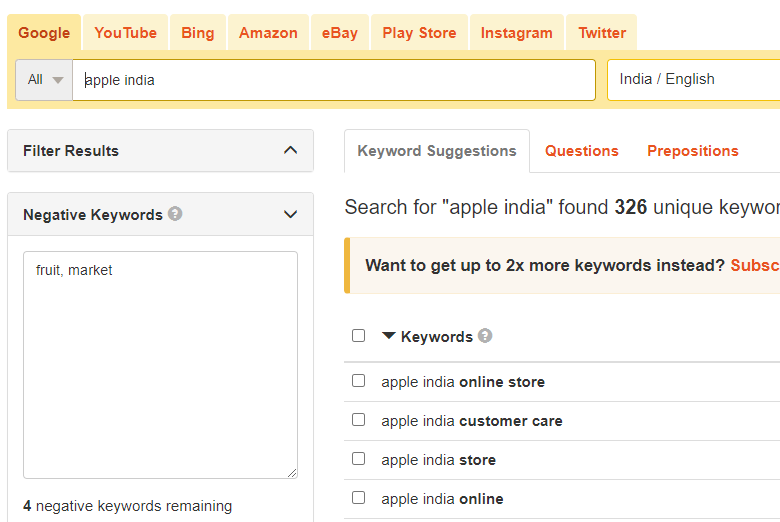
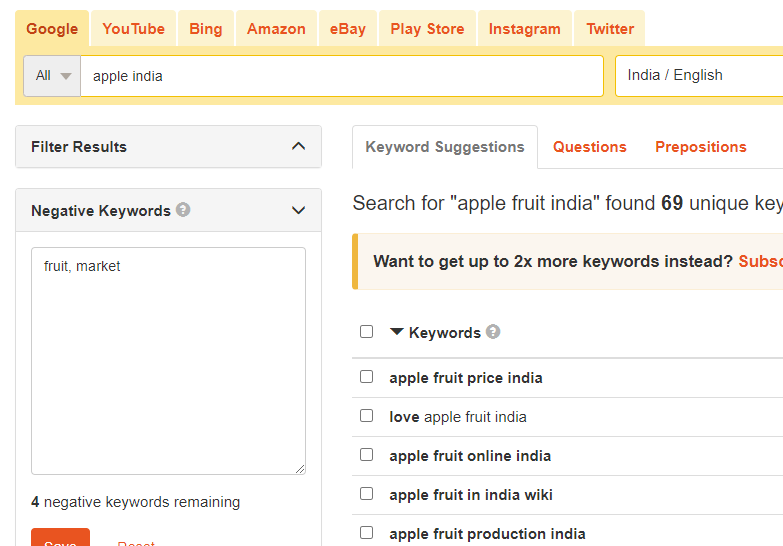
Keyword Tool’s main strength lies in finding long-tail keywords, hence it should be treated as such.
5. Moz keyword explorer – For lateral keywords
The Moz Keyword Explorer offers many unique features that place it above its competitors. Apart from their updated UI, Moz has a robust system for filtering keywords and finding relevant suggestions.
Moz’s related terms are not just other terms that include the original keys but are completely new but related terms. In other words, they truly look for lateral keywords, instead of using data from Google Keyword Planner and Suggest. The Moz Keyword Tool is a part of their larger SEO package that starts at 99 USD per month.
Keyword breakdown
Initially, Moz only offers the relevancy and monthly search volume of each term. It is only after you add them to your keyword list that Moz details them out. This could both be a pro or a con depending on how you work. As we see it, Moz removes unnecessary data dumping until you find something you’re interested in – which is great!
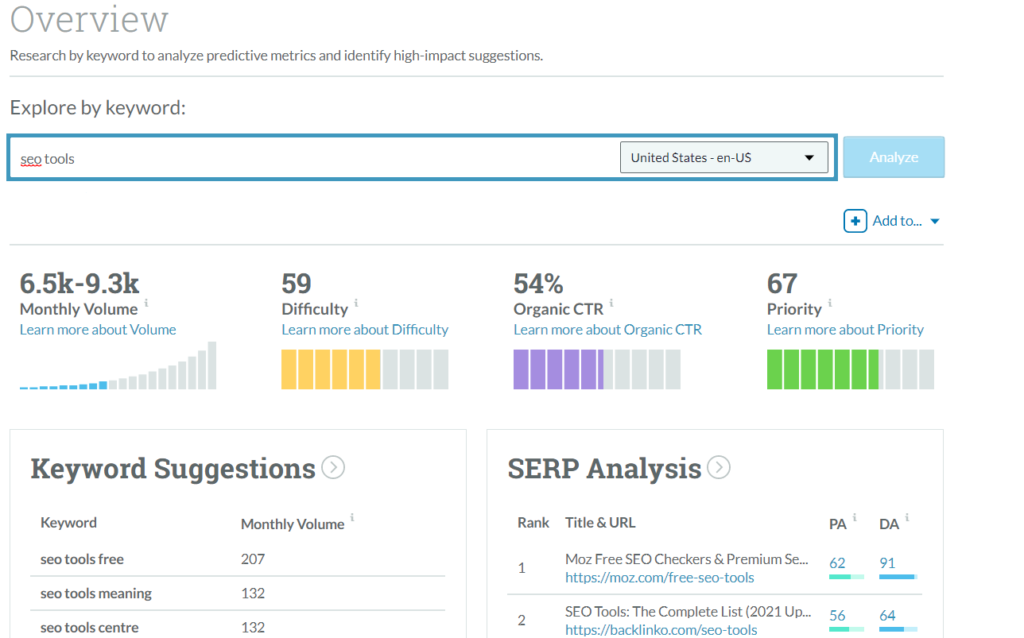
What we like: Moz’s opportunities and scores
Moz offers three tabs – Keyword Overview, Keyword Suggestions, and Keyword List. These provide more insights like its monthly volume, difficulty level, and ranking. It also allows you to customize your keyword list based on these suggestions:
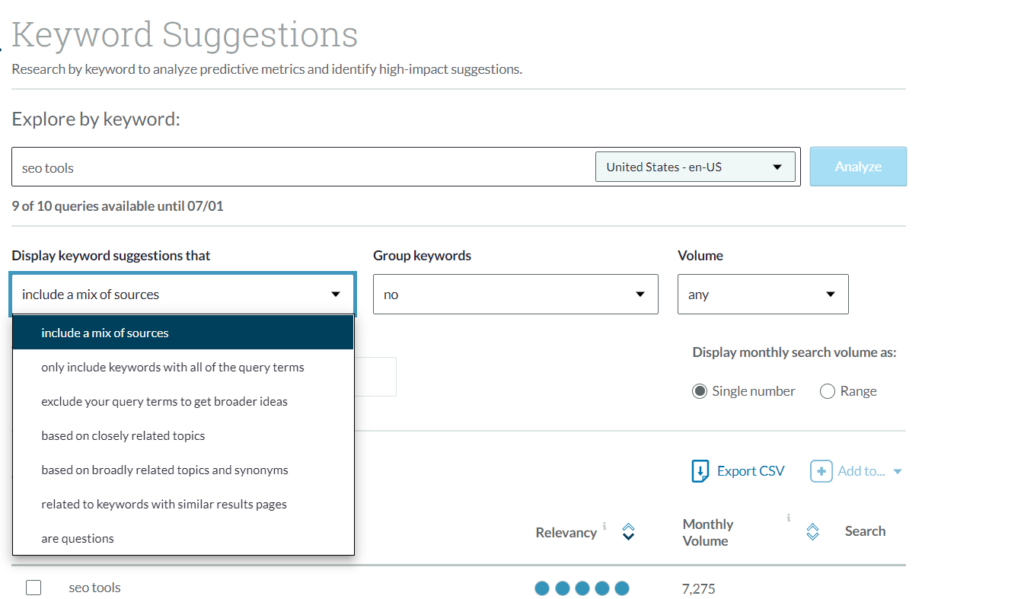
Two key data points Moz offers are this:
- The Opportunities – Moz assigns a lower score for keywords that have a higher CTR and vice versa. To find this, Moz assesses the top 10 links on Google. In fact, 28.5% of organic clicks are reserved for the top 1 result on Google.
- My Score – This is where Moz really shines. It analyses the common keywords for your business and then ranks the keywords with a score from 1 to 10 based on their relevance for YOUR content!
Where Moz could improve in the future is that it could allow multiple seed terms to be searched for at the same time.
6. Keywords Everywhere – Pay as you go
Keywords Everywhere are one of those tools that makes you wonder how it is still free! Unlike Soovle, they do not offer 150 different search engine data. The number cuts off at 16. However, that does not mean that Keywords Everywhere is any less robust.
In fact, they offer everything from CPC data, ranking, search volume and related keywords data for absolutely free. Currently, they offer two extensions for Chrome and Firefox. For a long time, Keywords Everywhere was absolutely free to use. But from October 2020 the team made certain features paid.
Despite this, Keywords Everywhere works on an extremely low-cost credit model that we will look at later.
What we like: The unique interface
Keywords Everywhere have a very different interface from the other tools on the list. It works on Google, eBay, Amazon, YouTube and more but integrates itself directly onto the site. So every time you use a supported search engine, it offers the stats on the right-side panel.
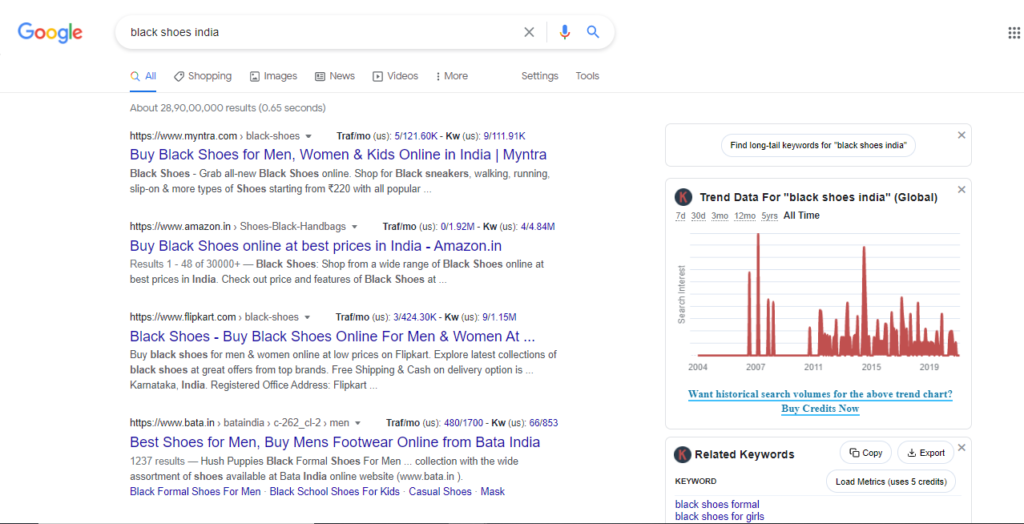
You can look at a visual representation of the trend data, related keywords, and long-tail keywords. One can also choose to look at the trend data based on a monthly, weekly or annual basis.
The trends chart is imported from Google Trends. Keywords Everywhere work on a credit basis. You can buy individual credits and use them to load further information as per your need.
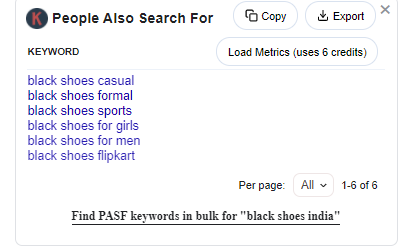
Here, you can see that access search volume and CPC data requires 6 credits. For 1 USD, you can buy 10,000 credit points. So you can see how cost-effective the tool is despite the new changes.
What the platform currently lacks is the Competitor Keyword Gap Analysis. However, the team assures us that it is currently in development and will be rolled out soon.
Simple control panel

Other than its unique interface Keywords Everywhere works similar to other tools. It allows you to export data as Excel or CSV files.
You can store your favorite keywords, analyze bulk traffic metrics or look for organic keywords (URL or domain-based) based on the ranking of the top 1,000 results on Google.
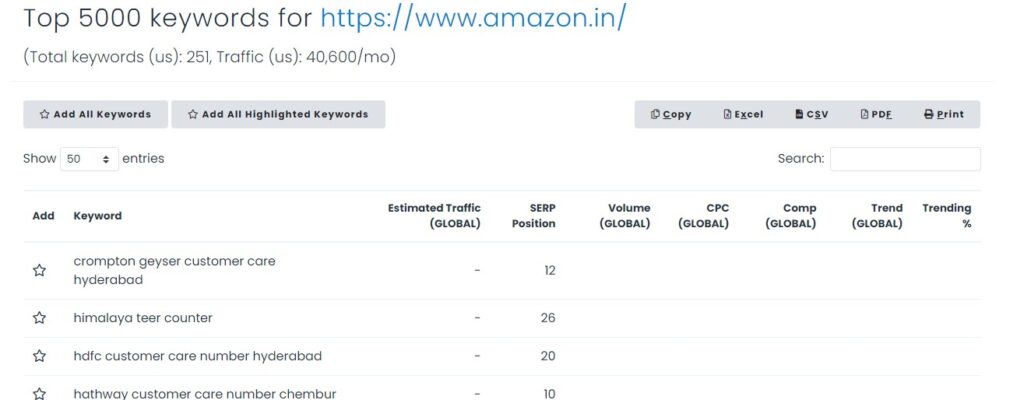
The URL-based organic keywords are currently free. For supported pages, one can look at the keyword density and volume. There are filters that allow easy sorting.

People also search for
Overall, where Keywords Everywhere rocks are in the keyword suggestions it offers. Despite being a free tool, Keywords Everywhere offers the “People Also Search For” feature. This is different from the related keywords section.
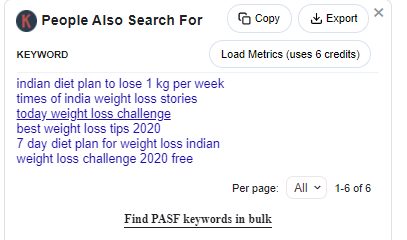
For example, here we performed a quick search for “weight loss trends India”. The People Also Search For section offers related terms like the 1kg per week diet loss plan, the 7-day diet plan and so on.
7. QuestionDB – A database of questions
Knowing the kind of questions that plague your target crowd could be an unequivocal help in figuring out the right kind of keywords and content. After all, most people refer to FAQs sections for help. Moreover, 27% of searches entered into search engines are questions with four or more words.
And QuestionDB is the best place for finding all that your target audience is curious about. It is a simple and free tool that allows up to 40 searches per month. People looking for more can sign up for the Pro Plan at 10 USD per month.
A simple interface
Along with a simple interface, QuestionDB brings a huge dataset with algorithms that even sift through Reddit searches! All you need to do is visit the website and enter the topic you are searching on into the search box. The results are displayed instantaneously and you can toggle between FAQs and keywords.
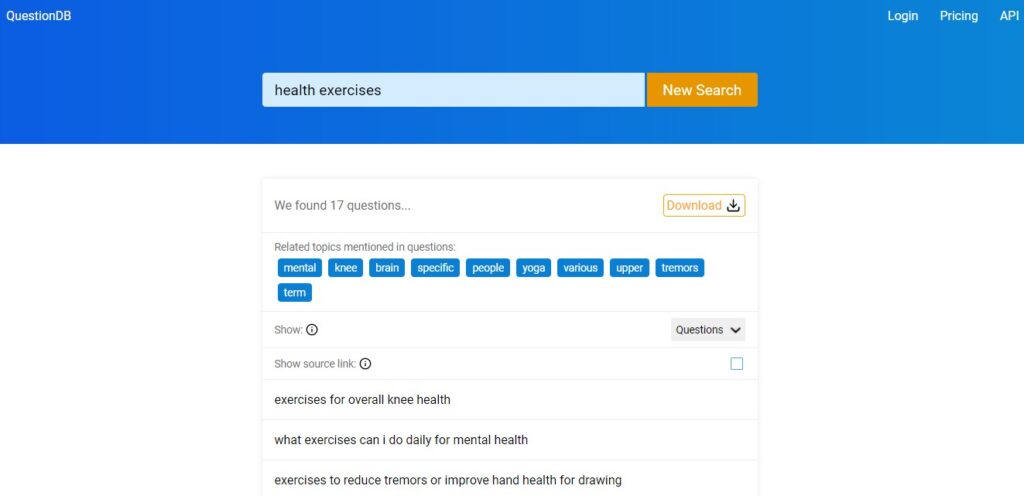
8. Serpstat – To check out your competitors
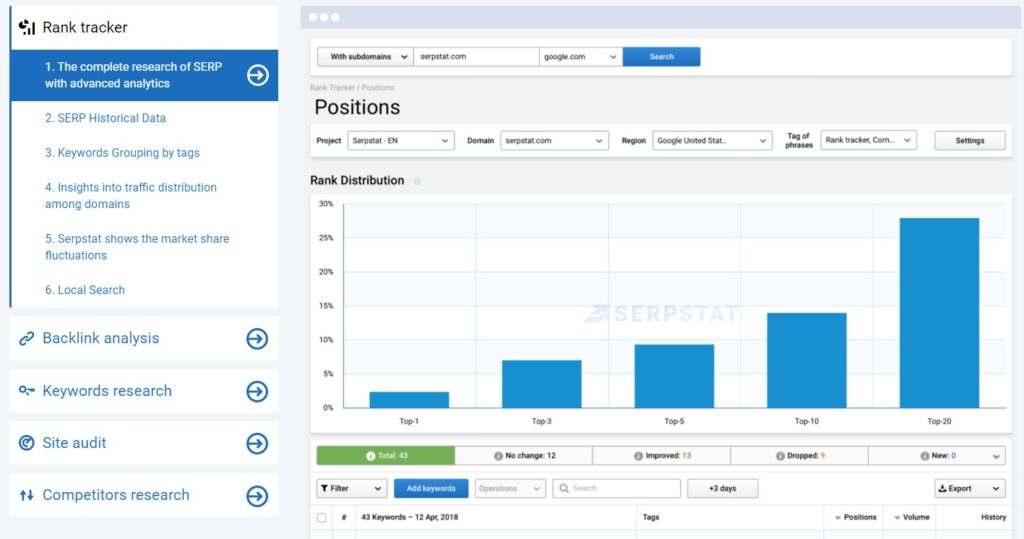
Listed as a “growth hacking tool”, Serpstat contains all SEO, PPC and content exploring tools that one could possibly ask for. Serpstat offers a familiar keyword research UI, along with a strong competitor analysis feature.
Serpstat’s website analysis includes an overview of your top keywords, traffic analytics, and changes in user volume. In this way, it is not much different from other existing platforms. One can check the top organic keywords for their site, their visibility, PPC and search volume. Along with that, you can integrate Google Ads to see which keyword rakes in the most.
Another feature is the list of top pages. These are the ones in which the keywords performed the best. They are not necessarily the pages visited the most, but are the ones that have the highest-performing organic keywords.
Keyword research
Despite being marketed as a growth tool, keyword research is the only content research feature Serpstat offers. Serpstat offers keyword suggestions and details including their search volume, the overall trend and CPC data. Along with this are the related searches and Google Autocomplete suggestions.
However, Serpstat’s one unique feature is it offers a list of one-word suggestions that are common amongst all features. You can consider it as a mind map of sorts that filters out the words common in most searches and suggestions.
Apart from this, Serpstat also has a rank tracking feature that keeps track of the target keywords set.
Competitor analysis
On the whole, Serpstat offers a standard competitor analysis. It includes details like their top-performing organic keywords, and also how much which keyword rakes in via Google.
Serpstat places heavy focus on organic searches. Hence, they have a report that lists your competitors based on organic searches. This is a really well-done feature. It also includes a visual graph that shows your positioning with respect to your competitors.
What we like: PPC research
What Serpstat does well is its PPC Research which is a step ahead of its contemporaries. The Serpstat PPC feature not only provides you with a list of the keywords your competitors are placing their bets on, but lets you see the exact ad copy as well.
Moreover, it can go a step further and show you the volume of their ads and the CPC. It can even direct you to the specific URL they are targeting for each ad!
Site audit
Serpstat’s site audit is an extremely quick and easy-to-use feature. A site audit essentially crawls your site for broken links, 404 errors or other issues. Serpstat’s site audit checks up on everything. Of course, the question arises – why is site audit relevant in an article about keyword tools? This is because Serpstat’s feature really checks everything from very small to very large issues.
This includes keyword cannibalizations, outdated tags, missing metadata, broken links and even tags that are too long! It even sifts through your content structure and alerts you if you have missed using keywords in headers, using the appropriate heading styles and so on.
Moreover, it segregates the issues into groups based on their priority level. So if you’re running short on time, you can simply choose to deal with the high-priority issue and leave the rest two stacks for some other day.
Serpstat comes with great customer support and an easy UI with an easy learning curve even for new users. Moreover, there are many tools rolled into one. You can use it for keyword research, site analysis, site audits, smart listening and more. The lowest stack starts off at $69 USD per month.
9. AlsoAsked – Ask the right questions
AlsoAsked mines data from the type of questions people have entered into Google search to generate related questions to a topic. Essentially, it offers semantically grouped questions that can help sellers to understand trending topics as well as concerns regarding them.
While the website itself offers some interesting visuals, those looking for textual information won’t be disappointed either. You can download the results in the form of an Excel file.
What we like: The Mind map
AlsoAsked makes use of PAA data which helps its algorithm to return more nuanced and connected questions than other similar sites. And it shows! AlsoAsked returns data in the form of a tree branching out. This is extremely useful in understanding the user journey from the main topic to the sub-topic. It could also be used to frame the FAQ section of a page.
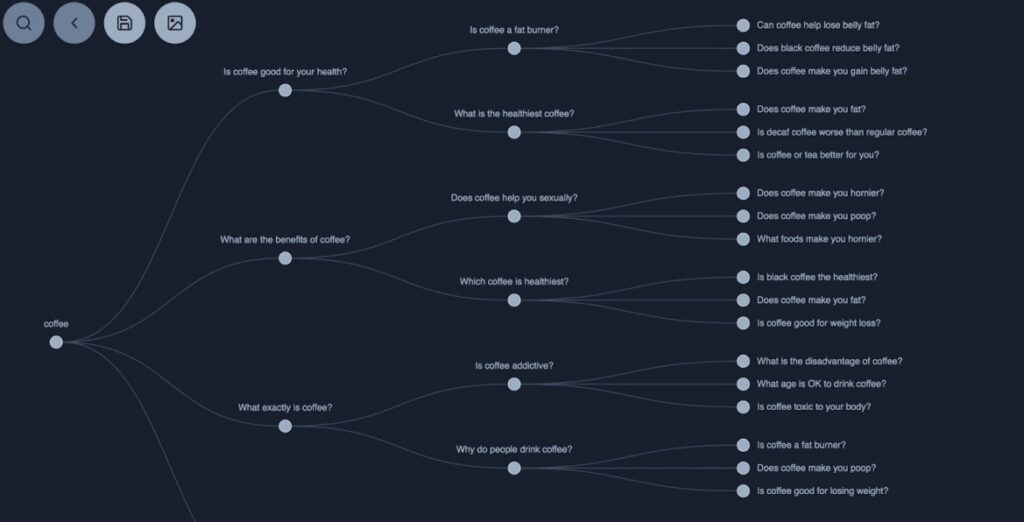
AlsoAsked offers suggestions separately based on the language and the country. Currently, the website is under maintenance.
10. Google Question Hub – The OG database
Perhaps the best place to find out what goes on within a customer’s mind is to head to where they look for their information! Essentially, Google Question Hub was created with the view to allow bloggers and content creators to cover gaps in user knowledge and leverage the existing knowledge database.
Accessing it is absolutely free and all one needs is a Search Console and Google account (Gmail). In India, Google Question Hub is available in both Hindi and English.
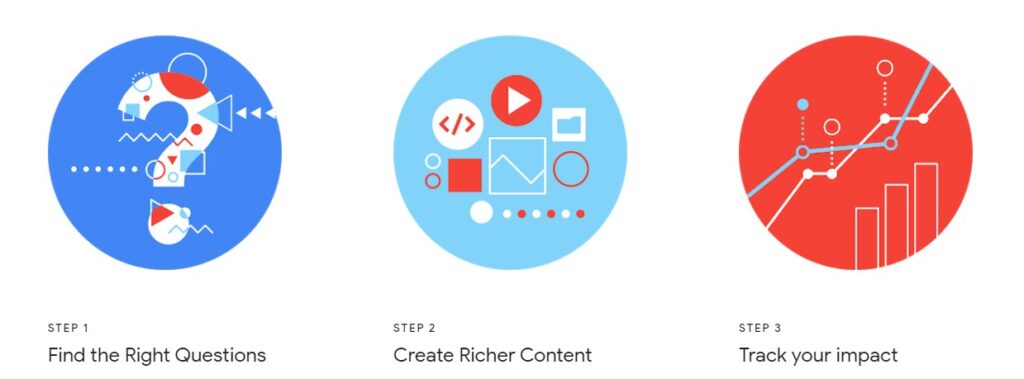
What we like: A User-Based Initiative
Google does so in a simple three-step process. Users reach out by posting a question anonymously. This is added to Google’s ever-growing database while being displayed. As a content creator, one can simply enter the topic they are concerned with and see the relevant user questions. Thus, Google has pulled a user-derived initiative here.
Based on your interests, the site will suggest questions. You can choose to answer these questions or reject them. Moreover, you can choose to link the answers to your site that covers them as well.
As a new initiative, Google Question Hub is not yet mobile-optimised and is not available across all countries either. However, it is easy to see the potential the site holds and its growth in the coming future.
11. Ahrefs – Best keyword research
Ahrefs started as a simple link-building tool. But over the years, it has branched out to include various other tools and features. Ahrefs has undoubtedly one of the strongest keyword research tools of the lot. Of course, apart from that, it also has a site explorer feature, backlink analysis and more.
Perhaps, the only complaint that even long-term Ahrefs users would make is its interface. While extremely informative, it also offers a large amount of data within a small space.
Keyword Tool
Ahrefs allows you to check the difficulty, global volume, trend and CPC of any phrase. Along with that, it offers similar phrases, question suggestions, and even trending topics! Moreover, Ahrefs collects data from Google, Yahoo, Bing, Yandex, YouTube and more.
Overall, they offer the most in-depth study of any keyword including their SERP positions and search volume across different countries. Not only this, but Ahrefs offers some great keyword suggestions as well. They do this with the help of something labelled as the ‘parent topic’ which we will look at now.
What we like: Parent topic
For every keyword, Ahrefs offers something known as the parent topic. This refers to the broader topic from which the currency keyword has branched out. The parent topic is not necessarily the common word from a phrase. Rather it is the original topic that gave rise to the next thread. Ahrefs mentions the possible ranking and volume of this keyword as well.
Hence, for a phrase like “health exercises to do at home”, the parent topic could be “exercises”. Ahrefs also uses this to semantically group its FAQs and keywords which results in much cleaner and related suggestions. This could be useful in figuring out what tags would be suitable for certain content.
Ahrefs Keywords Explorer is a robust tool that offers pretty much all types of data. Moreover, it is possible to do a complete deep dive and come up with amazing suggestions from their ‘Newly Discovered’ section. For those looking to find viable keywords, Ahrefs could be the best option.
12. Google Ads Keyword Planner – From Google itself
Google Ads comes with its very own keyword planning tool – the Google Ads Keyword Planner. As an extremely result-oriented ad-on to Google Ads, this Keyword Planner is focused on paid keywords that can give you a good ROI. It aims to help you find the right keywords to monetize. Hence, the Google Keyword Planner comes with various filters that allow you to zero in on the money makers.
Google uses data from its own servers across the world. Hence, it is a bit stilted as compared to those that access data from multiple search engines. To combat this, Google has teamed with various partners under their Search Network. As of now, this extends only to YouTube. Similar to Keyword Tool, Google Ads also gives you the option of filtering out negative keywords.
Keyword research
Google offers a decent amount of information regarding the top-performing keywords including their search volume and CPC. Along with that, Google will label the keyword with a high, medium or low difficulty level. However, it does not get more in-depth than that. In fact, this specific tool works best when integrated with other tools like Ahrefs or Keyword Planner that brings in more data.
Usually, one can only access the keyword planning tool after setting up their ad campaign, but you can choose to skip these steps or set up a dummy campaign in the meantime.
What we like: Advertising goals
As someone who benefits from the right ads, this tool is extremely results-focused. Hence, the first thing you need to set up is your advertising goal. All further keyword suggestions are based on what you aim to achieve.
This helps put the entire campaign into perspective. But also makes Google AdWords Keyword Tool primarily a marketing tool as opposed to the tool of a content creator.
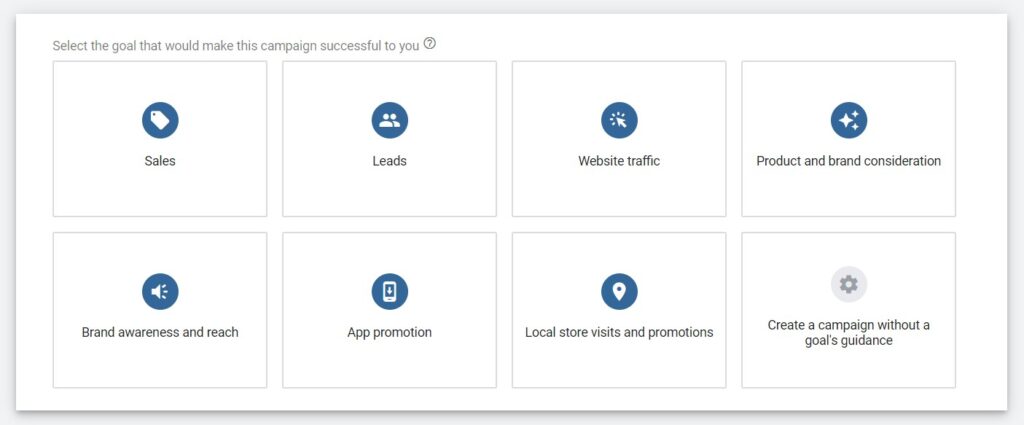
13. Rank Tracker – Suite of 20+ tools
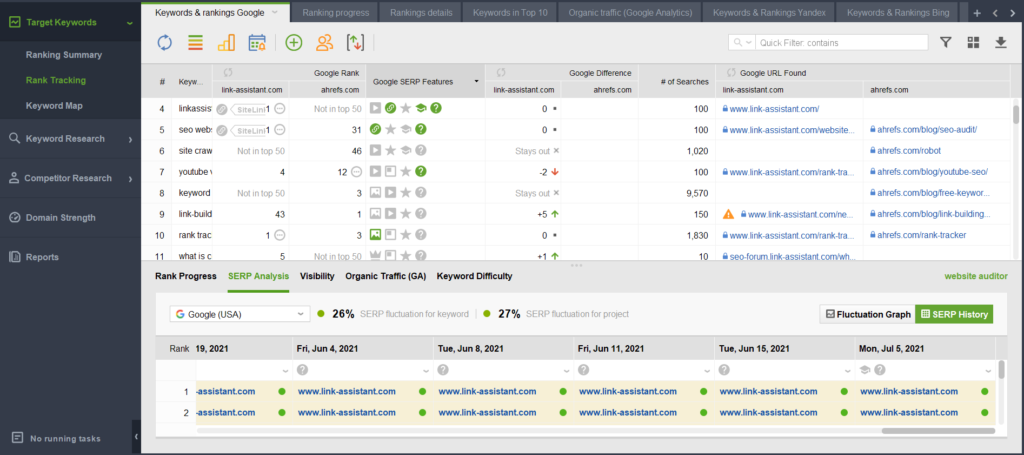
The Rank Tracker from SEO PowerSuite allows tracking organic rankings in all possible geo locations and search engines. There are dozens of useful SEO metrics to evaluate keywords: search volume, traffic, online visibility, keyword difficulty, PPC and CPC costs. Rank Tracker is integratable with Google Search Console, Google Analytics, Keyword Planner.
There are 20+ keyword research methods like Auto Suggestions, TF-IDF, Related Searches, autocomplete for YouTube, Amazon, etc. There are free, professional and enterprise versions of RT, with a 7-day free trial.
Keyword Breakdown
There is the Keyword Map where you save keywords into groups, map them to respective landing pages, and track their rankings. You can add numeric and semantic filters manually. There are also negative filters that can be applied before you start keyword research. There is a convenient feature of adding tags, that allows grouping keywords in various workspaces and setting some automatic tasks to keywords filtered by tags.
What we love about: Keeping record of SERP history
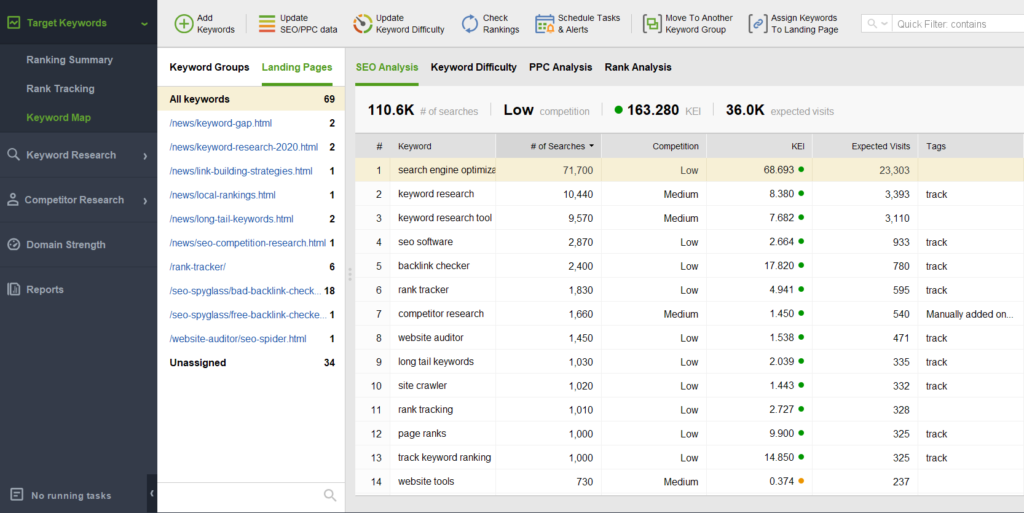
The tool allows collecting rich SERP features and keeping record of SERP history with top 10 to 30 results.
Professional versions of Rank Tracker supports unlimited number of keywords and projects, allows creating SEO reports, doing automatic ranking check-ups (or any task and alerts can be saved automatically to your email or in-cloud).
14. SEMrush – For detailed insights
Since we are on the subject of keyword tools, we shall only be looking at SEMrush’s Keyword Overview and Organic Search Feature. However, SEMrush offers a much larger and broader package than just that.
Keyword overview
SEMrush’s keyword overview tool offers details regarding the search volume, keyword difficulty, SERP results, overall trends and related questions. It offers variations of the same keyword along with other related terms. SEMrush rates keywords from 1 to 100 based on their ranking difficulty.
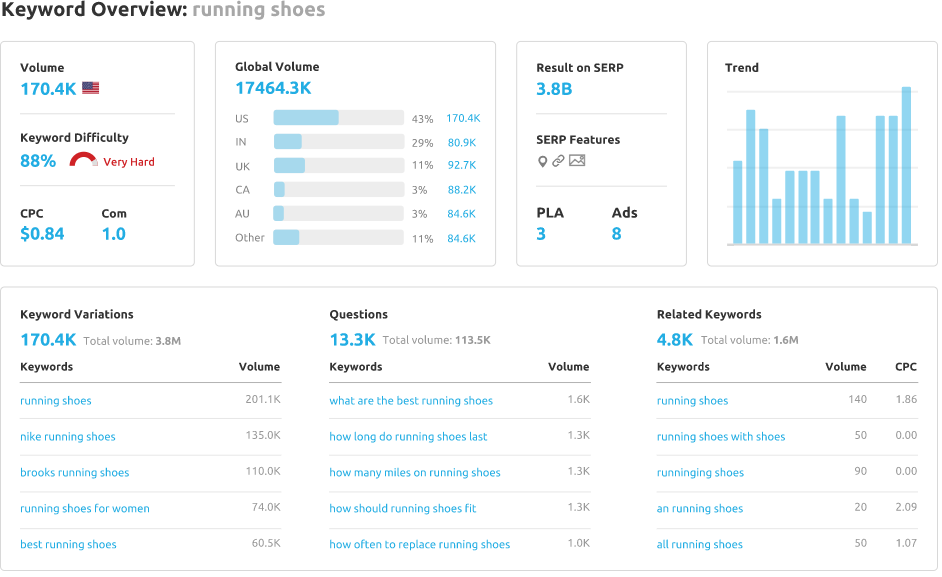
Keyword Magic Tool
In fact, if you are looking for some further suggestions, you can use the Keyword Magic Tool. The Magic tool lists all related keywords instead of detailing out one. It can help you find one that has been overlooked. You can filter them out by volume or difficulty level. The Magic Tool is a one-glance-tells-all look at the chosen phrase.

Keyword Analyzer
This is possibly the most useful feature SEMrush has come up with for content creators. After you select a keyword, what variation do you choose for your copy? This is where the Keyword Analyser Tool comes in. This tool allows you to enter one phrase. It then creates multiple variations and returns the seed term as well as the click potential of them all. All of these can be exported as Excel.
What we like: Ad history access
An interesting feature offered by SEMrush is the Ad History report. This allows you to access up to 4 years of data regarding PLAs and ads related to a certain keyword. If you have zeroed in on a time, you can even see the exact ad copy used! You can also check out the ad performance, i.e., the traffic they generated and the overall CPC.
In Conclusion,
So, we have taken a look at different keyword research tools along with their strong points and the type of industries that they are best suited towards. While some are great for all-around content marketing, some simply offer a one-step keyword list and require other integrations to be truly useful.
If you are looking for an all-in-one package, then SEMrush or SurferSEO are quite robust and industry-wide accepted solutions. Those looking to spend as they go can opt for a credit-based system that Keywords Everywhere offers. The flexibility that comes with such a package can be very freeing for SMBs looking to establish themselves before committing to a 200 USD per month package.
And yet, for those looking for free solutions, Soovle and QuestionDB remain good options. The key to good content is to work on creating something truly useful that aids others. However, considering the competitiveness in the market, using tools like these is a necessity.